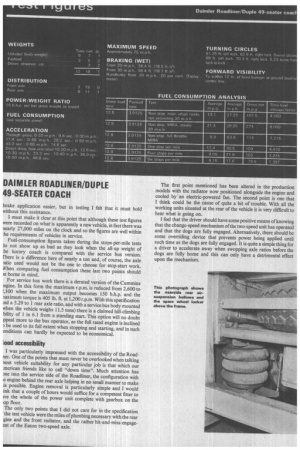DAIMLER ROADLINER/DUPLE 49-SEATER COACH
Page 65

If you've noticed an error in this article please click here to report it so we can fix it.
brake application easier, but in testing I felt that it must hold without this assistance.
I must make it clear at this point that although these test figures were recorded on what is apparently anew vehicle, in fact there was nearly 27,000 miles on the clock and so the figures are well within he requirements of vehicles in service.
Fuel-consumption figures taken during the stops-per-mile tests lo not show up as bad as they look when the all-up weight of be luxury coach is compared with the service bus version. ['here is a difference here of nearly a ton and, of course, the axle .atio used would not be the one to choose for stop-start work. When comparing fuel consumption these last two points should )e borne in mind.
For service bus work there is a derated version of the Cummins tngine. In this form the maximum r.p.m. is reduced from 2,600 to !,100 when the maximum output . becomes 150 b.h.p. and the laximum torque is 405 lb. ft, at 1,200 r.p.m. With this specification .nd a 5.29 to 1 rear axle ratio, and with a service bus body mounted when the vehicle weighs 11.5 tons) there is a claimed hill-climbing bility of 1 in 6.1 from a standing start. This option will no doubt ppeal more to the bus operator, as the full rated engine is inclined 3 be used to its full extent when stopping and starting, and in such onditions can hardly be expected to be economical.
Ind accessibility
I was particularly impressed with the accessibility of the Roadner. One of the points that must never be overlooked when talking pout vehicle suitability for any particular job is that which our .merican friends like to call "down time". Much attention has me into the service side of the Roadliner, the configuration with e engine behind the rear axle helping in no small manner to make is possible. Engine removal is particularly simple and I would ink that a couple of hours would suffice for a competent fitter to we the whole of the power unit complete with gearbox on the op floor.
The only two points that I did not care for in the specification 'the test vehicle were the miles of plumbing necessary with the rear gine and the front radiator, and the rather hit-and-miss engageent of the Eaton two-speed axle. The first point mentioned has been altered in the production models with the radiator now positioned alongside the engine and cooled by an electric-powered fan. The second point is one that I think could be the cause of quite a bit of trouble. With all the working units situated at the rear of the vehicle it is very difficult to hear what is going on.
I feel that the driver should have some positive means of knowing that the change-speed mechanism of the two-speed unit has operated and that the dogs are fully engaged. Alternatively, there should be some overriding device that prevents power being applied until such time as the dogs are fully engaged. It is quite a simple thing for a driver to accelerate away when swopping axle ratios before the dogs are fully home and this can only have a detrimental effect upon the mechanism.




































































































































